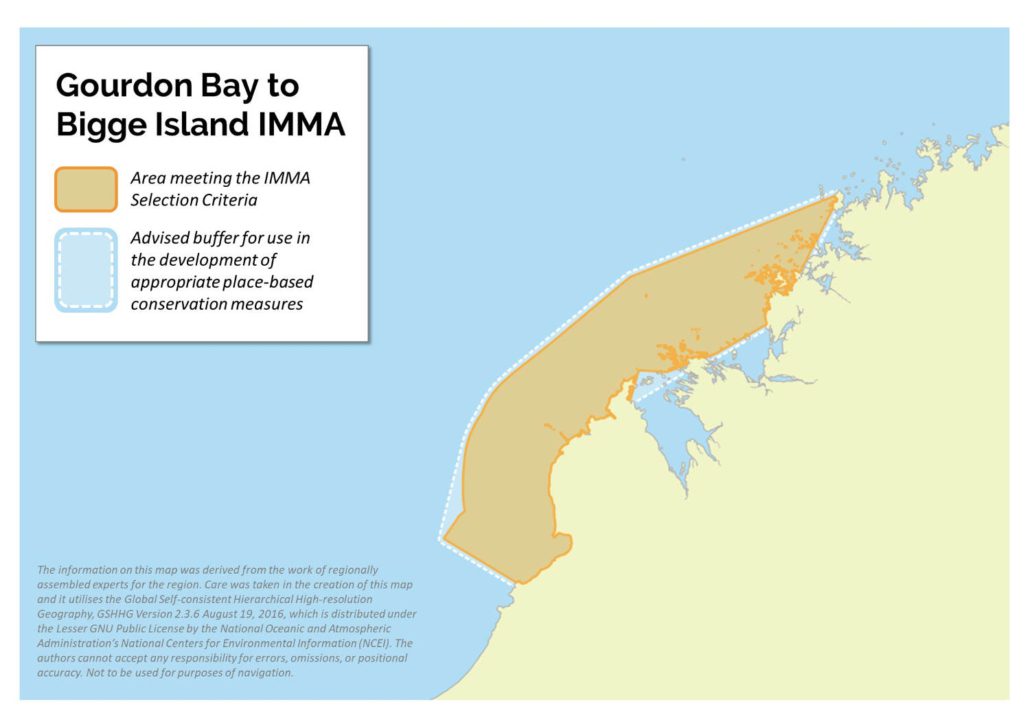Gourdon Bay to Bigge Island IMMA
Size in Square Kilometres
57,941 km2
Qualifying Species and Criteria
Humpback whale – Megaptera novaeangliae
Criterion B (2); C (1)
Marine Mammal Diversity
Balaenoptera edeni, Physeter macrocephalus, Balaenoptera physalus, Stenella longirostris, Pseudorca crassidens, Tursiops truncatus, Tursiops aduncus, Orcaella heinsohni, Sousa sahulensis
Download factsheet
Summary
This IMMA in northwest Australia is an important humpback whale breeding area. Extending from Eighty Mile Beach in the south to Camden Sound in the north (~15°S – 18°S), it encompasses the Lalang-garram / Camden Sound Marine Park (Dept. of Parks and Wildlife, 2013), which was one of the first Marine Parks established in the Kimberley region and that provides special management mechanisms to protect humpback whales. The Marine Park recognises the important habitat of the area for humpback whales and other species of special conservation interest (sawfish, saw toothed rays) and includes sea country of several saltwater country people (e.g. Yawuru, Bardi Jawi, Mayala and Dambimangari). This area contains several large marine embayments, an elaborate arrangement of islands and reef and complex bathymetry of shoals, rock platforms and soft sediment. Humpback whales occur here in large numbers between June and November each year during the austral winter and utilise different areas during the breeding season. Peak whale abundance occurs in August with the main use of the region at this time in the northern extent near Camden Sound, with other important areas including Pender Bay and Buccaneer Archipelago (Jenner et al. 2001, Thums et al. 2018).
Description of Qualifying Criteria
Criterion B: Distribution and Abundance
Sub-criterion B2: Aggregations
The IMMA is a well-known seasonal aggregation area for humpback whales and encompasses the core breeding area for this population. A large proportion of the population aggregate here off the Kimberley coast each year during the austral winter between July and September (Dawbin and Gill 1991, Jenner et al. 2001, Thums et al. 2018). Satellite tag data indicates that this is the terminal destination for the majority of the population (Gales et al. 2010). Within the breeding area, Jenner et al. (2001) and Thums et al. (2018) have identified from boat-based and aerial survey data several key areas where whales have been observed to aggregate: Pender Bay, Tasmanian Shoals and Buccaneer Archipelago. The time of peak abundance in the breeding ground is in August, with greatest occupancy within the occurring between Pender Bay and Camden Sound (Thums et al. 2018).
Criterion C: Key Life Cycle Activities
Sub-criterion C1: Reproductive Areas
This area is critical to reproduction for this population of humpback whales, with the majority of mating and calving occurring here. The occurrence of mating and calving in this area is based on observations of newborn calves, increasing numbers of calves in this area throughout the breeding season and all breeding behaviours (e.g. competitive groups, mother-calf pairs, newborn calves, singing) (Dawbin & Gill, 1991, Jenner et al. 2001, Thums et al. 2018).
Supporting Information
Dawbin, W.H. and Gill, P.C. 1991. Humpback whale survey along the west coast of Australia: a comparison of visual and acoustic observations. Memoirs of the Queensland Museum 30:255-257.
Department of Parks and Wildlife 2013, Lalang-garram / Camden Sound Marine Park management plan 73 2013–2023, Department of Parks and Wildlife, Perth.
Gales, N., M.C. Double, M.C., Robinson, S., Jenner, C., Jenner, M., King, E., Gedamke, J., Childerhouse, S. and Paton, D. 2010. Satellite tracking of Australian humpback (Megaptera novaeangliae) and pygmy blue whales (Balaenoptera musculus brevicauda). Report (SC/62/SH21) to the Scientific Committee of the International Whaling Commission.
Jackson, J., Ross-Gillespie, A., Butterworth, D., Findlay, K., Holloway, S., Robbins, J., Rosenbaum, H., Weinrich, M., Baker, C.S. and Zerbini, A. 2015. Southern Hemisphere humpback whale comprehensive assessment – a synthesis and summary: 2005–2015. Report (SC/66a/SH/3) to the Scientific Committee of the International Whaling Commission. 38pp.
Jenner, K.C.S., M.N.M. Jenner and K. A. McCabe. 2001. Geographical and temporal movements of humpback whales in western australian waters. APPEA Journal 38:749-765
Salgado Kent, C.P., Jenner KCS, Jenner M, Rexstad E.A. 2012. Southern Hemisphere breeding stock ‘D’ humpback whale population estimates from North West Cape, Western Australia. Journal of Cetacean Research and Management 12:29-38
Thums M, Jenner C, Waples K, Salgado Kent C, Meekan M. 2018. Humpback whale use of the Kimberley; understanding and monitoring spatial distribution. Report of Project 1.2.1 prepared for the Kimberley Marine Research Program, Western Australian Marine Science Institution, Perth, Western Australia, 78pp.


